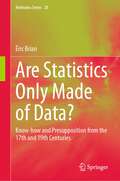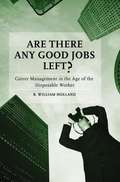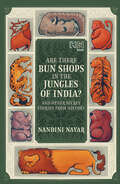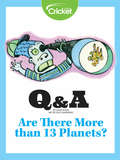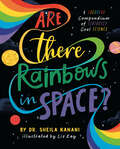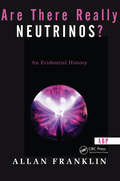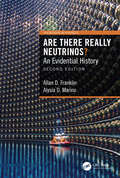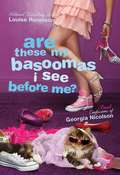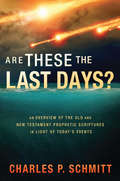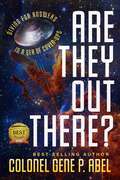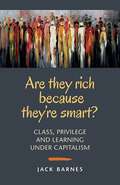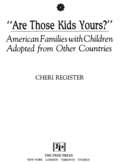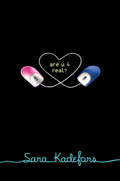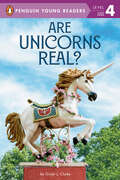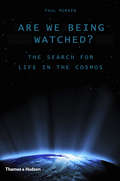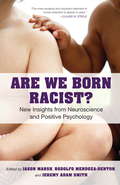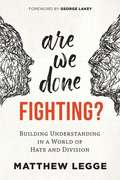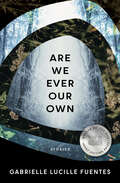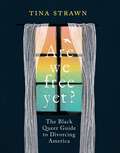- Table View
- List View
Are Statistics Only Made of Data?: Know-how and Presupposition from the 17th and 19th Centuries (Methodos Series #20)
by Éric BrianThis book examines several epistemological regimes in studies of numerical data over the last four centuries. It distinguishes these regimes and mobilises questions present in the philosophy of science, sociology and historical works throughout the 20th century. Attention is given to the skills of scholars and their methods, their assumptions, and the socio-historical conditions that made calculations and their interpretations possible. In doing so, questions posed as early as Émile Durkheim’s and Ernst Cassirer’s ones are revisited and the concept of symbolic form is put to the test in this particular survey, conducted over long period of time. Although distinct from a methodological and epistemological point of view, today these regimes may be found together in the toolbox of statisticians and those who comment on their conclusions. As such, the book is addressed to social scientists and historians and all those who are interested in numerical productions.
Are There Any Good Jobs Left? Career Management in the Age of the Disposable Worker
by R. William HollandThis book is for and about the millions of people who are between jobs (code for "out of work"), have been between jobs, or know of someone who has been. It is about how to navigate the transition from employment-for-life, career development support, and a company-sponsored pension to downsized, outsourced, and replaced. Bill Holland explains the macro-trends that have converged to create an environment of job instability and anxiety, and then moves beyond this context to present specific tactics and techniques that readers can use to stay one step ahead in their careers. More than a manual for job searches and career-building strategies, Are There Any Good Jobs Left? helps readers interpret trends, assess such temptations as leaving the corporate rat race for the entrepreneurial life and considers the ethics of constant networking. Featuring an annotated listing of books and Web sites, the book is not so much an indictment of corporate disloyalty as an explanation of the phenomenon, and a guidebook for anyone faced with job transition, change, or growth in today's turbulent environment.
Are There Bun Shops in the Jungles of India? And Other Secret Stories from History
by Nandini NayarWhen was the last time the MIGHTY tiger roamed freely under the open sky?What is the SLEEK leopard from sunny India doing in FREEZING England?How will the HUGE rhinoceros stay in a SMALL, cramped cage?And why, oh why, is the ENORMOUS elephant eating tiny BUNS in the zoo?Leopards and cheetahs, bears and antelopes, monkeys and deer...it's the same SORRY tale. These animals from India have been CAGED for the amusement of people - to be prodded and poked and teased! It's upsetting. It's shocking. It's breaking our hearts. What are we to DO? Well, we have written letters - a whole SHEAF of them - to the owners of menageries and the zoo, asking them to STOP this cruelty NOW. To give the animals the food, the care and the freedom they deserve. But ARE they reading them? Are YOU?
Are There International RandD Spillovers Among Randomly Matched Trade Partners? A Response to Keller
by David T. Coe Alexander W. HoffmaisterA report from the International Monetary Fund.
Are There More than 13 Planets?
by Lizzie WadeAre there more than 13 planets in our solar system? Learn how astronomers catagorize the objects out in space.
Are There Negative Returns to Aid? A Comment
by Mwanza NkusuA report from the International Monetary Fund.
Are There Rainbows in Space?: A Colorful Compendium of Seriously Cool Science
by Sheila KananiWhat color is a polar bear under its fur? How do flamingos turn pink? What is a blue moon? Find the answers to all these fun questions and much more in this fact-filled adventure into the colorful world around us!The science of colors is hard at work all the time—from ultraviolet light to the baby blue tint of the sky. Readers will learn tons of interesting scientific facts about color and its whys and hows—like why blood is red, how hippos keep cool, and how some animals can change color to hide from predators. Bursting with incredible illustrations and some seriously cool science, this book is sure to dazzle both nature lovers and reluctant readers alike.
Are There Really Neutrinos?: An Evidential History
by Allan FranklinIn this intriguing and accessible book, physicist Allan Franklin examines the experiments on neutrino oscillations. He argues that this history gives us good reason to believe in the existence of the neutrino, a particle that interacts so weakly with matter that its interaction length is measured in light years of lead. Only recently, the scientific process has provided evidence of the elusive neutrino. Written in a style accessible to any reader with a college education in physics, Are There Really Neutrinos? is of interest to students and researchers alike.
Are There Really Neutrinos?: An Evidential History (Frontiers in Physics)
by Allan D. Franklin Alysia D. MarinoThis intriguing and accessible book examines the experiments on neutrino oscillations. It argues that this history gives us good reason to believe in the existence of neutrinos, a particle that interacts so weakly with matter that its interaction length is measured in light years of lead. Yet, the scientific process has provided evidence of the elusive neutrino. Written in a style accessible to any reader with a college education in physics, Are There Really Neutrinos? is of interest to students and researchers alike. This second edition contains a new epilogue highlighting the new developments in neutrino physics over the past 20 years.
Are These My Basoomas I See Before Me?
by Louise RennisonFor Georgia, the more things change, the more they stay the same. Just when she thought she was the official one-and-only girlfriend of Masimo, he's walked off into the night with the full hump, leaving Georgia all aloney on her owney-again. All because Dave the Laugh tried to do fisticuffs at dawn with him! Two boys fighting over Georgia? It's almost as romantic as Romeo and Juliet . . . though perhaps a touch less tragic. It's time for Georgia to get to the bottom (oo-er) of this Dave the Laugh spontaneous puckering business once and for all. It's like they always say: If you snog a mate in the forest of red bottomosity and no one is around to see it, is he still a mate? Or is he something more?</p?
Are These the Last Days?
by Charles Schmitt“The path of the righteous is like the first gleam of dawn, shining ever brighter till the full light of day.” —Proverbs 4:18, NKJV Solomon says in Proverbs 4:18 that we can expect an increase in enlightenment and an expansion of understanding as we approach the last days. That is Charles P. Schmitt’s position as he presents a fresh scrutiny of Old and New Testament prophetic scriptures in the light of today's world events. He traces not only the conflict between Israel and the Arab world but also their amazing last-days promises of restoration. At all times he underscores the primary backdrop for any Christian view of the last days: worldwide evangelism before the end comes. Are These the Last Days? will graciously challenge your status quo understanding of end-time prophecies and enable you, as Solomon said, to see this subject in an “ever brighter” light.
Are They All in the Same Boat? The 2000-2001 Growth Slowdown and the G-7 Business Cycle Linkages
by Tamim Bayoumi Thomas HelblingA report from the International Monetary Fund.
Are They Out There?: Diving for Answers In a Sea of Cover-Ups
by Gene P. Abel&“If you're ready to read a realistic approach to the possibility of alien life and whether we are visited by them, you will love Are They Out There? Diving for Answers In a Sea of Cover-Ups.&” – Readers&’ FavoriteNothing in the universe is unique and alone, and therefore in other regions there must be other earths inhabited by different tribes of men and different breeds of beast. - Titus Lucretius, De Rerum Natura circa 50BCE The question, Are They Out There? is not a new one. Since ancient times, humans have wondered about the potential of alien life. Between May 1, 2023, and June 1, 2024, alone, sightings of more than seven hundred unidentified aerial phenomena were reported-and twenty-one of these cases are still under investigation. They can't be explained by common objects. In Are They Out There? retired Colonel Gene P. Abel sifts through the accounts of military professionals and eyewitnesses alike in search of the truth about extra-terrestrial visitors. Discover what Colonel Abel has uncovered, and what the government might not be telling us, in this gripping new look at the history, and potential future impact, of UFOs, and alien contact. A newly released US report on unidentified flying objects says 143 sightings since 2004 remain unexplained. It does not rule out alien activity. - The New York Times, June 25, 2021
Are They Rich Because They’re Smart?: Class, Privilege And Learning Under Capitalism
by Jack BarnesThe 2020 print edition was used as the source for text and page numbers. Description: (Use back cover text from print edition) Are They Rich Because They’re Smart? explains the sharpening class inequalities in the United States and the resulting conflicts accelerated by today’s slow-burning world depression. It takes apart the self-serving rationalizations of a growing layer of well-paid professionals that their schooling and ‘brightness’ equip them to ‘regulate’ the lives of working people, who can’t be trusted to know what’s in our own interests. In the coming battles forced upon us by the capitalist rulers, says Jack Barnes, workers will begin to transform ourselves and our attitudes toward life, work, and each other. Only then will we discover our own worth and learn what we’re capable of becoming.
Are Those Kids Yours?: American Families With Children Adopted From Other Countries
by Cheri RegisterCherie Register draws on her experience as the mother of two Korean-born daughters and interviews with adoptive families to illustrate the special challenges multicultural families face.
Are U 4 Real?
by Sara KadeforsKyla is exactly the kind of girl Alex could never talk to in real life. She's a gorgeous, outspoken L. A. girl who parties to forget about her absent father and depressed mother. He's a shy ballet dancer from outside San Francisco who's never been kissed. Luckily, when these sixteen-year-olds meet for the first time it's not in real life-it's in a chat room, where they can share their feelings of isolation and frustration away from the conformity-obsessed high school scene. Alex and Kyla quickly forge a friendship that's far from virtual- maybe they're even falling in love. But what happens when the soul mate you've never met moves from online to in person? Sara Kadefors's wildly romantic, award-winning Swedish bestseller perfectly captures the universal angst of being a teenager, and the perhaps even more universal struggle to negotiate identity in a multi-platform world.
Are U.S. Military Interventions Contagious over Time?: Intervention Timing and Its Implications for Force Planning
by Jennifer KavanaghCurrent DoD force planning processes assume that U. S. military interventions are serially independent over time. This report challenges this assumption, arguing that interventions occur in temporally dependent clusters in which the likelihood of an intervention depends on interventions in the recent past. The author used data on 66 U. S. Army contingency and peacekeeping deployments of at least company size between 1949 and 2010 and found evidence of temporal dependence between military interventions even when controlling for political, economic, and other security factors. However, the results also suggested that clustering is affected by the nature of the geopolitical regime and is stronger at certain points than others, for example, after the Cold War as compared to during the Cold War. The results suggested that as few as two military interventions above average is often enough to trigger interventions in subsequent years. Because current planning processes address only the direct force demands of a given deployment and ignore the heightened risk for additional demands created by temporal dependence, these processes may project force requirements that understate the demands placed on military deployments during a period of clustered interventions. This analysis suggests that DoD should consider modifying the integrated security constructs to incorporate serial correlation of interventions, making assumptions about the nature of the current or future geopolitical regime explicit, and assessing whether the existing set of force planning frameworks reflects the spectrum of potential future geopolitical regimes. Book jacket.
Are Unicorns Real? (Penguin Young Readers, Level 4)
by Ginjer L. ClarkeLearn about the history of unicorns in this photographic nonfiction leveled reader perfect for kids interested in the natural - and unnatural - world!Did you know that the Siberian unicorn roamed the Earth during the last Ice Age? Or that technically any creature with one horn is considered a unicorn? That means narwhals, certain antelope, and even shrimp with a horn can be called unicorns!Embracing childrens' delight in the mythical creatures while also imparting fascinating facts about the real ones, discover the history of this special animal and decide for yourself if you believe in unicorns!With simple language and vivid photographs, Are Unicorns Real? is perfect for emerging readers curious about the natural world and the iconic creature.
Are We Alone? Scientists Search for Life in Space
by Gloria SkurzynskiIn the jungle of Puerto Rico, next to a giant aluminum telescope bowl, we meet astronomers Peter Backus and Jill Tarter of the SETI (Search for Extraterrestrial Intelligence) program. This research program is determined to find evidence of extraterrestrial life by searching for its radio signals. They hope to catch radio waves created by some kind of life far out in space. These scientists love their work: "Arriving in the control room, Jill puts on a tape of her favorite samba music by a group called Viva Brazil. Others in the room stay seated and propel themselves on their wheeled office chairs from workstation to workstation, but Jill usually gets up and sambas across the floor. "In this rare combination of engaging narrative and factual information, Gloria Skurzynski uses techniques she's developed as a fiction writer to energize her science writing. This book not only brings the reader into the world of extra-terrestrial science, but is also very much about the hopes and dreams of real people. She lends a strong personal voice to the narrative, drawing the reader deep into the world of extraterrestrial study. Humans have always been fascinated with extraterrestrial life, and the book traces that interest, including the origination of the term "flying saucer. " Sloan also explains why scientists don't buy it. "There's been no hard evidence, not a single artifact left behind-a lost boot, or a shred of whatever material the UFO was made of, or even a flake of alien skin. "But not believing in flying saucers doesn't mean scientists don't believe in extraterrestrial life. They look for it using telescopes, space missions, and planet explorations. They study extremophiles, organisms that live in extreme environments on Earth, in the hopes that they will lead us to a better understanding of how life may exist in space. Really, what could be out there? This book visits scientists across the globe who are trying to find out, from Puerto Rico to California, from Socorro, New Mexico to Chile, Finland, Spain, and Hawaii. And, what's on tap for the future of extraterrestrial study? Researchers study hydrothermal vents deep under the sea, create super-sensitive radio telescopes, and scour the highest lake in the world. Extremely well written, filled with little-known facts, and often quite humorous, this book brings to life a subject that children are intrigued by. Our time is truly a fascinating moment in scientific exploration, and this book will help anyone get a jump on the search for E. T. Who knows? Maybe there's an alien as close as next-door?a next-door planet, that is!
Are We Being Watched?: The Search for Life in the Cosmos
by Paul MurdinAn engaging exploration with renowned astronomer Paul Murdin of how life emerged on Earth--and the possibilities that it exists elsewhere There is no more fascinating question than whether or not we are alone in a vast universe. Here, Paul Murdin applies the latest scientific discoveries and theories to inquire whether life exists on other planets and, if so, what forms it might take. Could there be somewhere life as advanced as here on Earth, or are we more likely to find primitive life-forms? Or are we the sole living organisms in a desolate and boundless cosmos? Professor Murdin invites us to join him in exploring an extraordinary array of evidence to determine if there is life elsewhere in the cosmos. He examines the case for life on Mars and Europa and asks whether on Enceladus or Titan we might find the "warm little" pond that Darwin speculated was where life began here on Earth. Describing the cosmic habitats that produce the alien worlds of our solar system and others, he examines the chances of finding life and the prospects for successful communication with an extraterrestrial intelligence.
Are We Born Racist?
by Jeremy A. Smith Jason Marsh Rodolfo Mendoza-DentonWhere do our prejudices come from? Why are some people more biased than others? Is it possible for individuals, and society as a whole, to truly defeat prejudice? In these pages, leading scientists, psychologists, educators, activists, and many others offer answers, drawing from new scientific discoveries that shed light on why and how our brains form prejudices, how racism hurts our health, steps we can take to mitigate prejudiced instincts, and what a post-prejudice society might actually look like. Bringing a diverse range of disciplines into conversation for the first time, Are We Born Racist? offers a straightforward overview of the new science of prejudice, and showcases the abundant practical, research-based steps that can be taken in all areas of our lives to overcome prejudice.
Are We Done Fighting?: Building Understanding In A World Of Hate And Division
by George Lakey Matthew Legge Adam FarnsworthUnfounded beliefs and hateful political and social divisions that can cascade into violence are threatening to pull the world apart. Responding to fear and aggression strategically and with compassion is vital if we are to push back against the politics of hate and live in greater safety and harmony. <p> But how to do it? <p> Are We Done Fighting? is brimming with the latest research, practical activities, and inspirational stories of success for cultivating inner change and spreading peace at the community level and beyond. <p> Packed with inspiration and cutting-edge findings from fields including neuroscience, social psychology, and behavioural economics, Are We Done Fighting? is an essential toolkit for activists, community and peace groups, and students and instructors working to build dialogue, understanding, and peace as the antidote to the politics of hate and division.
Are We Ever Our Own (American Reader Series #38)
by Gabrielle Lucille FuentesMoving between Cuba and the U.S., the stories in Are We Ever Our Own trace the paths of the women of the far-flung Armando Castell family. Related but unknown to each other, these women are exiles, immigrants, artists, outsiders, all in search of a sense of self and belonging. The owner of a professional mourning service investigates the disappearance of her employees. On the eve of the Cuban revolution, a young woman breaks into the mansion where she was once a servant to help the rebels and free herself. A musician in a traveling troupe recounts the last day she saw her father. Linked by theme and complex familial bonds, these stories shift across genres and forms to excavate the violence wreaked on women’s bodies and document the attempt to create something meaningful in the face of loss. They ask: who do we belong to? What, if anything, belongs to us?
Are We Free Yet?: The Black Queer Guide to Divorcing America
by Tina Strawn"Liberation is ultimately a celebration of our deepest humanity, and our fight for it must include a deeper examination of how we relate to oppressive systems while centering our joy, peace, and pleasure." — Tina StrawnAre We Free Yet? The Black Queer Guide to Divorcing America is simultaneously a personal reflection and a collective examination of our relationship to liberation and oppression. In it, Tina Strawn, host of the Speaking of Racism podcast and Instagram platform of the same name, shares her intimate experiences of queerness and Blackness, heartbreak and loss, foreign and home, as she navigates and finds freedom. Alongside Tina's personal journey through a year of challenging transitions, Are We Free Yet? offers an interactive guide to four pillars of activism: joy, liberation, pleasure, and connection. From the role of cannabis to the importance of embracing our grief, this book offers a critical take on all it means to be an activist, offering deep reflection and discussions on race, social change, sex, and healing. Divorce expert (divorced from a husband, a wife, and a country) and author Tina Strawn will challenge readers to: Question what freedom means and looks like in their lives. Consider what leaving the country could look like for them. See themselves (their preferences, personality traits, and biases) in their activism. Deeply investigate what it means to them to be an American and to love or not love "your" country. About the Author: Tina Strawn is a joy and liberation advocate, activist, author, and the owner and host of the Speaking of Racism (IG: @speakingofracism) podcast. The heart of her work is leading Legacy Trips (IG: @legacytrips), immersive antiracism experiences where participants visit historical locations such as Montgomery and Selma, AL, and utilize spiritual practices as tools to affect personal and collective change. Tina has three adult children, an ex-husband, an ex-wife, and an ex-country. She has been a full-time minimalist nomad since February 2020. Tina travels the globe speaking, writing, teaching, and exploring where on the planet she can feel safe and free in her/their queer, Black, woman-identifying body.
